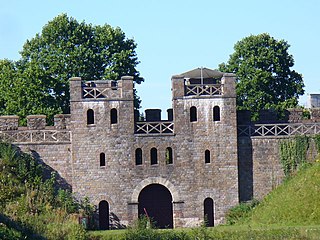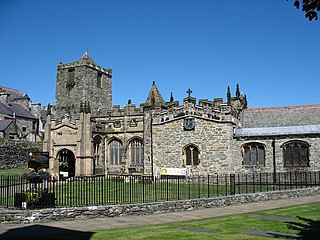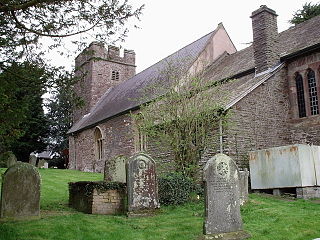
Caer is a placename element in Welsh meaning "stronghold", "fortress", or "citadel", roughly equivalent to an Old English suffix (-ceaster) now variously written as -caster, -cester, and -chester.

Holyhead is the largest town and a community in the county of Isle of Anglesey, Wales, with a population of 13,659 at the 2011 census.. Holyhead is on Holy Island, bounded by the Irish Sea to the north, and is separated from Anglesey island by the narrow Cymyran Strait and was originally connected to Anglesey via the Four Mile Bridge.

Holy Island is an island on the western side of the larger Isle of Anglesey, Wales, from which it is separated by the Cymyran Strait. It is called "Holy" because of the high concentration of standing stones, burial chambers, and other religious sites on the small island. The alternative English name of the island is Holyhead Island. According to the 2011 UK Census, the population was 13,659, of whom 11,431 (84%) lived in the largest town, Holyhead.
Salomon was a late 5th century Cornish 'warrior prince', possibly a King of Cornwall. His feast day takes place on the 18 October. He was the father of the Cornish bishop Saint Cybi.
Red Wharf Bay, also known as Traeth Coch, is a village and a sandy bay in Anglesey, Wales. The bay lies between the villages of Pentraeth and Benllech. It is also close to Castell Mawr Rock, thought to be the site of an Iron Age fort.

Seiriol was an early 6th-century saint, who created a cell at Penmon Priory on Anglesey, off the coast of north Wales. He later moved to Ynys Seiriol.

Saint Cybi (Welsh), or Cuby (Cornish), was a 6th-century Cornish bishop, saint, and, briefly, king, who worked largely in Cornwall and North Wales: his biography is recorded in two slightly variant medieval 'lives'.

Caer Gybi was a small fortlet in Roman Wales in the Roman province of Britannia Superior. Its name in Latin is unknown. Today it stands at the centre of Holyhead in the Welsh county of Anglesey. Holyhead is named Caergybi in Welsh, after the fort.

Anglesey is an island off the north-west coast of Wales. It forms the bulk of the county known as the Isle of Anglesey, which also includes Holy Island and some islets and skerries. The county borders Gwynedd across the Menai Strait to the southeast, and is otherwise surrounded by the Irish Sea. Holyhead is the largest town, and the administrative centre is Llangefni. The county is part of the preserved county of Gwynedd.

Baron of Cymmer-yn-Edeirnion, in the county of Merioneth, is a dormant title used by the Hughes of Gwerclas, the senior male-line descendants of Prince Owain Brogyntyn, youngest son of Madog ap Maredudd, King of Powys. Owain Brogyntyn divided his lands equally between his three sons on his death, and his eldest son, Iorwerth, inherited lands centred on Cymmer, in the parish of Llangar and commote of Edeirnion. His son, Gruffydd ab Iorwerth, fought against Edward I during his invasion of Wales. After the Conquest of Wales, Gruffydd came "into the King's peace", and on 22 July 1284, had his lands confirmed by Edward I per baroniam, 'just as his ancestors had held them', thereby creating him a baron in the English feudal baronage. The first surviving use of the title was by Gruffydd's grandson, Owain, who in 1334 was summoned to the sessions at Harlech as Owenus ap Davidus,Dominus de Kimmer. Some authorities, therefore, date the barons from Owain, whereas others begin with Gruffydd. In the fifteenth century their principal residence was known as Plas o Cymmer, and was later renamed Plas Uchaf. Later the 10th Baron moved to the nearby mansion of Gwerclas.

The Roman conquest of Anglesey refers to two separate invasions of Anglesey in North West Wales that occurred during the early decades of the Roman conquest of Britain in the 1st century CE. The first invasion of North Wales began after the Romans had subjugated much of southern Britain. It was led by the Provincial governor of Britannia, Suetonius Paulinus, who led a successful assault on the island in 60–61 CE, but had to withdraw because of the Boudican revolt. In 77 CE, Gnaeus Julius Agricola's thorough subjugation of the island left it under Roman rule until the end of Roman rule in Britain in the early 5th century CE. The invasions occurred because Anglesey, which was recorded in Latin as Mona was a place of resistance to Roman rule because it was an important centre for the Celtic Druids and their religious practices.
Caffo was a sixth-century Christian in Anglesey, north Wales, who is venerated as a saint and martyr. The son of a king from northern Britain who took shelter in Anglesey, Caffo was a companion of St Cybi, and is mentioned as carrying a red-hot coal in his clothes to Cybi without his clothes getting burnt. After leaving Cybi, Caffo was killed by shepherds in the south of Anglesey, possibly acting in retaliation for insults Caffo's brother had paid to the local ruler. The area where he died has a village, Llangaffo, named after him, as well as the parish church of St Caffo, Llangaffo.

St Mary's Church, Llanfair-yn-y-Cwmwd is a small medieval parish church near the village of Dwyran, in Anglesey, north Wales. The building probably dates from the 15th century, with some alterations. It contains a 12th-century carved stone font and a 13th-century decorated coffin lid. The bell is inscribed with the year of its casting, 1582. The historian Henry Rowlands was vicar of St Mary's in the late 17th and early 18th centuries. Maurice Wilks, who invented the Land Rover, is buried in the churchyard.
A clas was a native Christian church in early medieval Wales. Unlike later Norman monasteries, which were made up of a main religious building supported by several smaller buildings, such as cloisters and kitchens, a clas was normally a single building. The building was run by a community of clergy and headed by an abod. Clasau were autonomous and were administered locally.

St Enghenedl's Church, Llanynghenedl, is a former parish church in Anglesey, north Wales, dedicated to the son of a 6th-century King of Powys. According to the 19th-century antiquarian Angharad Llwyd, the first church in Llanynghenedl was erected in about 620. A new church was erected in 1862, replacing a building that the 19th-century clergyman and antiquarian Harry Longueville Jones noted as dating in part from the late 13th or early 14th century, based on the decorations on the south doorway. The church later fell into disuse as a result of the growth of the nearby village of Valley and the church there. In 1988, St Enghenedl's was dismantled and re-erected as an extension to St Mihangel's, Llanfihangel yn Nhowyn, so that St Mihangel's could serve as the church for RAF Valley. The former churchyard of St Enghenedl's is still visible but is now overgrown.(The churchyard is being cared for and no longer overgrown 2020 update)

Eglwys y Bedd is all that remains of a 14th-century church in Anglesey, north Wales. It is set within the churchyard of St Cybi's, Holyhead, and may have been built on the site where Cybi lived and ministered. It is reputed to house the grave of Seregri, an Irish warrior who lived in the area in the 5th century.

Saint Cyngar was a 5th-century Welsh Saint. He is the Patron Saint of Llangefni, Anglesey, in Wales, and a founding member of St. Cybi's Monastery at Holyhead, Anglesey.

St Mary's Church was a Church in Wales parish church in Llanfair-yn-Neubwll, Anglesey, Wales. The current building was constructed in the 14th century, possibly on the site of a 12th-century church. It was restored in 1857. The church was deconsecrated in the 1970s and is a Grade II-listed building.
Mybbard and Mancus were two Cornish saints of the 6th century.















